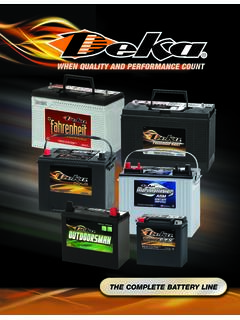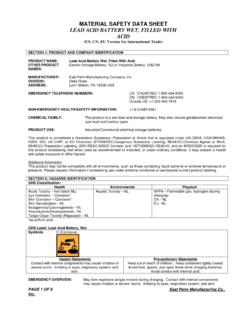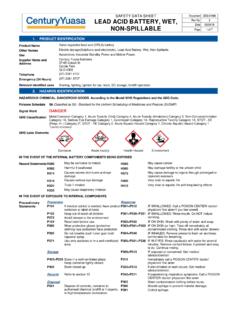Transcription of SAFETY DATA SHEET - East Penn Manufacturing
1 SAFETY data SHEET1. IdentificationLead acid battery Wet, Filled With AcidProduct identifierOther means of identificationmay include gel/absorbed electrolyte type lead acid batteriesSynonymsElectric storage useNone restrictionsManufacturer/Importer/Suppli er/Distributor informationEast Penn Manufacturing Company, Deka Road, Lyon Station PA 19536 Address(610) 682-6361 Telephone numberEast Penn EHS DepartmentContact personUSA/Canada: CHEMTREC (800) 424-9300, Outside USA 1 (703) 527-3887 Emergency Hazard(s) identificationNot hazardsCategory 4 Acute toxicity, oralHealth hazardsCategory 4 Acute toxicity, inhalationCategory 1 ASkin corrosion/irritationCategory 1 Serious eye damage/eye irritationCategory 1 ACarcinogenicityCategory 1 AReproductive toxicityEffects on or via lactationReproductive toxicityCategory 1 (respiratory system)Specific target organ toxicity, single exposureCategory 3 respiratory tract irritationSpecific target organ toxicity, single exposureCategory 1 (respiratory system)
2 Specific target organ toxicity, repeatedexposureCategory 1 Hazardous to the aquatic environment, acutehazardEnvironmental hazardsCategory 1 Hazardous to the aquatic environment,long-term hazardNot defined hazardsLabel elementsSignal wordDangerHazard statementThe materials contained in this product may only represent a hazard if the integrity of the cell orbattery is compromised; physically, thermally, or electrically abused. The below are the hazardsanticipated under those conditions:Harmful if swallowed. Harmful if inhaled. Causes severe skin burns and eye damage. May causecancer. May damage fertility or the unborn child. May cause harm to breast-fed children. Causesdamage to organs (respiratory system). Causes damage to organs (respiratory system) throughprolonged or repeated exposure.
3 May cause respiratory irritation. Very toxic to aquatic life withlong lasting acid battery Wet, Filled With AcidSDS US923330 Version #: 03 Revision date: 31-August-2020 Issue date: 19-September-20171 / 9 Precautionary statementPreventionObtain special instructions before use. Do not handle until all SAFETY precautions have been readand understood. Keep away from heat/sparks/open flames/hot surfaces. - No smoking. Do notbreathe dust/mist/vapors. Do not eat, drink or smoke when using this product. Avoid contactduring pregnancy/while nursing. Wear protective gloves/protective clothing/eye protection/faceprotection. Wash thoroughly after handling. Use only outdoors or in a well-ventilated area. Avoidrelease to the swallowed: Rinse mouth. Do NOT induce vomiting. If on skin (or hair): Take off immediately allcontaminated clothing.
4 Rinse skin with water/shower. If inhaled: Remove person to fresh air andkeep comfortable for breathing. If in eyes: Rinse cautiously with water for several contact lenses, if present and easy to do. Continue rinsing. Immediately call a poisoncenter/doctor. Wash contaminated clothing before reuse. Collect in a well-ventilated place. Keep container tightly to manufacturer/supplier for information on recovery/recycling. Dispose ofcontents/container in accordance with local/regional/national/international (s) not otherwiseclassified (HNOC)None informationIn use, may form flammable/explosive vapor-air normal conditions of processing and use, exposure to the chemical constituents in thisproduct is unlikely. The battery should not be opened or burned. Exposure to the ingredientscontained within or their combustion products could be Composition/information on ingredientsMixtures7439-92-143 - 70 Lead and lead compounds(inorganic)CAS number%Chemical name7664-93-920 - 44 Electrolyte (Sulfuric acid )7440-36-03 - 5 AntimonyAll concentrations are in percent by weight unless ingredient is a gas.
5 Gas concentrations are inpercent by composition concentrations will vary with battery type/size. The manufacturer has claimedthe exact percentage as trade secret under the OSHA Hazard Communication comments4. First-aid measuresExposure to contents of an open or damaged battery : Move injured person into fresh air and keepperson under observation. Get medical attention if any discomfort to contents of an open or damaged battery : Immediately flush with plenty of water for atleast 15 minutes while removing contaminated clothing and shoes. Get medical attention ifirritation develops and contactExposure to contents of an open or damaged battery : Flush thoroughly with water for at least 15minutes. Hold eyelids open during flushing. If irritation persists, repeat flushing. Get medicalattention if irritation develops and contactExposure to contents of an open or damaged battery : Rinse mouth thoroughly with water.
6 DO NOTinduce vomiting because of danger of aspirating liquid into lungs. Get medical normal conditions of processing and use, exposure to the chemical constituents in thisproduct is unlikely. The battery should not be opened or burned. Exposure to the ingredientscontained within or their combustion products could be lead exposure may result in central nervous system damage, encephalopathy and damageto the blood-forming (hematopoietic) importantsymptoms/effects, acute anddelayedTreat of immediatemedical attention and specialtreatment neededEnsure that medical personnel are aware of the material (s) involved, and take precautions toprotect information5. Fire-fighting measuresDry chemical, foam, carbon dioxide, water extinguishing mediaLead acid battery Wet, Filled With AcidSDS US923330 Version #: 03 Revision date: 31-August-2020 Issue date: 19-September-20172 / 9Do NOT use water on live electrical extinguishingmediaBatteries evolve flammable hydrogen gas during charging and may increase fire risk.
7 Containersmay explode when hazards arising fromthe chemicalSelf-contained breathing apparatus and full protective clothing must be worn in case of of respiratory protection for firefighting: follow the general fire precautions indicated inthe protective equipmentand precautions for firefightersIn case of fire do not breathe fumes. Move container from fire area if it can be done without fightingequipment/instructionsUse standard firefighting procedures and consider the hazards of other involved methodsLike any sealed container, battery cells may rupture when exposed to excessive heat; this couldresult in the release of corrosive and flammable fire hazards6. Accidental release measuresAvoid contact with precautions,protective equipment andemergency proceduresNeutralize the spilled material before disposal.
8 Sweep up or vacuum up spillage and collect insuitable container for disposal. Dispose of waste and residues in accordance with local and materials forcontainment and cleaning upPrevent runoff from entering drains, sewers, or precautions7. Handling and storageIn the event of damage resulting in a leak of exposed materials, avoid contact with contents of anopen or damaged cell or battery . Keep away from heat, sparks and open flame. Do not allowconductive material to touch the battery terminals. A dangerous short-circuit may occur and causebattery failure and fire. Pregnant or breastfeeding women must not handle this for safe handlingStore in original tightly closed container. Protect containers from damage. Place cardboardbetween layers of stacked batteries to avoid damage and short for safe storage,including any incompatibilities8.
9 Exposure controls/personal protectionOccupational exposure limitsUS. OSHA Specifically Regulated Substances (29 CFR ) mg/m3 Lead and lead compounds(inorganic) (CAS7439-92-1)US. OSHA Table Z-1 Limits for Air Contaminants (29 CFR ) mg/m3 Antimony (CAS 7440-36-0)PEL1 mg/m3 Electrolyte (Sulfuric acid )(CAS 7664-93-9)US. ACGIH Threshold Limit mg/m3 Antimony (CAS 7440-36-0) mg/m3 Thoracic (Sulfuric acid )(CAS 7664-93-9) mg/m3 Lead and lead compounds(inorganic) (CAS7439-92-1)US. NIOSH: Pocket Guide to Chemical mg/m3 Antimony (CAS 7440-36-0)TWA1 mg/m3 Electrolyte (Sulfuric acid )(CAS 7664-93-9)Lead acid battery Wet, Filled With AcidSDS US923330 Version #: 03 Revision date: 31-August-2020 Issue date: 19-September-20173 / 9US. NIOSH: Pocket Guide to Chemical mg/m3 Lead and lead compounds(inorganic) (CAS7439-92-1)No biological exposure limits noted for the ingredient(s).
10 Biological limit valuesACGIH Biological Exposure IndicesValueComponentsDeterminantSpecime nSampling Time200 g/lLeadBlood*Lead and lead compounds(inorganic) (CAS7439-92-1)* - For sampling details, please see the source adequate ventilation. Provide easy access to water supply and eye wash engineeringcontrolsIndividual protection measures, such as personal protective equipmentNone under normal conditions. Leak from a damaged or opened battery : Wear SAFETY glasses withside shields (or goggles) and a face protectionSkin protectionNone under normal conditions. Leak from a damaged or opened battery : Wear appropriatechemical resistant gloves. Glove material : Nitrile rubber Layer thickness: or mmBreakthrough time: 240 or 480 min. Suitable gloves can be recommended by the glove protectionSkin protectionNone under normal conditions.













